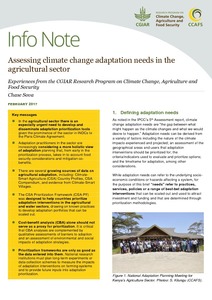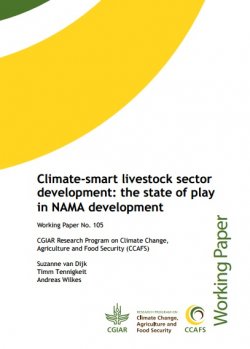Energy-smart food at FAO: an overview
This paper presents FAO’s work on energy in relation to specific components of the agrifood chain. It complements two recent publications, Energy-Smart Food for People and Climate Issues Paper and the
This paper presents FAO’s work on energy in relation to specific components of the agrifood chain. It complements two recent publications, Energy-Smart Food for People and Climate Issues Paper and the
The climate-smart agriculture (CSA) Data Atlas and Training Guidebook can help operationalize Kenya’s Climate-Smart Agriculture Strategy (KCSAS) and its framework at the county level by building capacity
<p>Sustainable development of Indian cities is an essential pre-requisite for India to establish itself as a major economic power. Smart cities dwell on energyefficient urban centres. The National Action
<p>Agrifood systems are facing an escalating threat from climate change-induced loss and damage, and actions – including increasing financing— must be taken to address their vulnerabilities, according to this new report by the Food and Agriculture Organization of the United Nations (FAO).</p>
Urban sprawl costs the American economy more than US$1 trillion annually, according to a new study by the New Climate Economy. These costs include greater spending on infrastructure, public service delivery
Due to gender-specific roles and responsibilities, men and women face varying challenges and opportunities to mitigate and adapt to climate change impacts. It is particularly important to take into account
As a national development model that simultaneously pursues socio-economic progress and environmental conservation, the Green Growth concept is being tested in countries around the world through context-specific
<p> The Asia-Pacific Trade and Investment Report (APTIR) is a recurrent publication prepared by the Trade and Investment Division. It aims to deepen understanding of regional trends and developments
<p>This 200-page report by Biodiversity International provides solid evidence that investments in agrobiodiversity also play a critical yet overlooked role in tackling wider global targets such as reducing poverty and malnutrition, reversing environmental degradation and combatting climate change. It demonstrates that agrobiodiversity can be a more mainstream approach to sustainable development</p>

In the agricultural sector there is an especially urgent need to develop and disseminate adaptation prioritization tools given the prominence of the sector in INDCs to the Paris Climate Agreement. Adaptation
Developing countries can meet climate targets promised in the landmark Paris Agreement by catalyzing trillions of dollars in private investments through a combination of smart policy reforms and innovative
This report was compiled by Ecofys to support The New Climate Economy (NCE) and the publication of a report on the role of international collaboration in climate action, which provides ten recommendations
Shimla: Himachal Pradesh has moved a step closer to signing an agreement with the World Bank (WB) to avail a Rs 1,000 crore Development Policy Loan (DPL). The loan is a first of its kind foreign assistance
Most countries in sub-Saharan Africa (SSA), including Ghana, rely on agriculture for their income and food security. Any initiative that might help to sustain and improve productivity in agriculture would
Scaling insurance to transfer climate risk from the rural poor to financial markets is vital to enhance agricultural risk management in developing countries, but insurance programs need to address several
Scaling insurance to transfer climate risk from the rural poor to financial markets is vital to enhance agricultural risk management in developing countries, but insurance programs need to address several
<p>Investing in sustainable infrastructure is the growth story of the future and the global South will account for two thirds of global infrastructure investment (or about US$4 trillion per year). This new infrastructure offers a great opportunity to “leapfrog” the inefficient, sprawling and polluting systems of the past</p>
The project Integrated agricultural technologies for enhanced adaptive capacity and resilient livelihoods in climate-smart villages (CSVs) of Southeast Asia aims to provide climate-smart agriculture (CSA)
Zambia’s agricultural sector represents the backbone of its rural economy and holds great potential for the entire country. Zambia’s agriculture sector faces challenges and is likely to grow more vulnerable

Given the projected increase in the demand for animal-source foods in developing countries, trends in livestock GHG emissions and other environmental impacts, there is an urgent need to change livestock